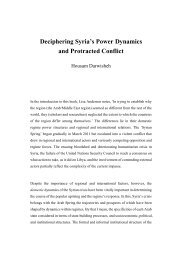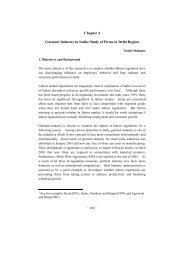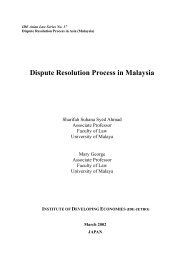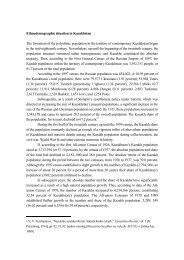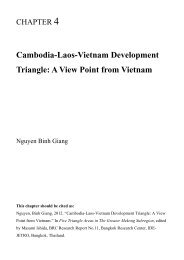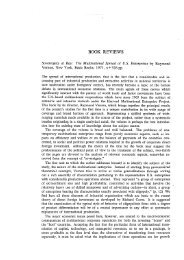Trade patterns and global value chains in East Asia: - IDE-JETRO
Trade patterns and global value chains in East Asia: - IDE-JETRO
Trade patterns and global value chains in East Asia: - IDE-JETRO
Create successful ePaper yourself
Turn your PDF publications into a flip-book with our unique Google optimized e-Paper software.
<strong>Trade</strong> Patterns <strong>and</strong> Global Value Cha<strong>in</strong>s <strong>in</strong> <strong>East</strong> <strong>Asia</strong>IntroductionThe geographical fragmentation of production hascreated a new trade reality. Often referred to as<strong>global</strong> <strong>value</strong> <strong>cha<strong>in</strong>s</strong> or vertical specialization, thisfragmentation deepens the <strong>in</strong>terdependency of traderelations <strong>and</strong> has many implications for how weunderst<strong>and</strong> trade policy. This book sheds light on thenature of this <strong>in</strong>terdependency, <strong>and</strong> the contributionof trade to national economies. It illustrates theconjunction of technical, <strong>in</strong>stitutional <strong>and</strong> politicalchanges that led to the emergence of production <strong>and</strong>trade networks <strong>in</strong> <strong>East</strong> <strong>Asia</strong>, <strong>in</strong>clud<strong>in</strong>g their impact ontrade <strong>patterns</strong>.As shown <strong>in</strong> the diagram, the rise of <strong>global</strong> <strong>value</strong><strong>cha<strong>in</strong>s</strong> results from the conjunction of several factors.It started with a change <strong>in</strong> the consumption models of<strong>in</strong>dustrialized economies, which found a supply potential<strong>in</strong> some develop<strong>in</strong>g countries. The book also showshow this development approach, <strong>in</strong>itially centred on afew lead<strong>in</strong>g economies that had adopted an export-led<strong>in</strong>dustrialization strategy, enabled a larger number ofregional partners to embark on an <strong>in</strong>dustrialization paththat had deep implications for their domestic economies.This structural shift <strong>in</strong> the function<strong>in</strong>g of <strong>in</strong>ternationaltrade requires, <strong>in</strong> turn, that the tools used to analyse itsevolution, <strong>in</strong> particular trade statistics, be adapted.International dem<strong>and</strong>Development of<strong>in</strong>frastructure<strong>and</strong> trade policyIndustrial process<strong>in</strong>g zonesOffshor<strong>in</strong>g-outsourc<strong>in</strong>gstrategies <strong>and</strong> FDIGlobal Value Cha<strong>in</strong>s (GVCs)<strong>and</strong> world tradeIncrease of trade <strong>in</strong><strong>in</strong>termediate goodsNeed for new statisticalmeasures of <strong>in</strong>ternationaltradeDomestic/territorialimpact of GVCsThe first chapter recalls that <strong>global</strong>ization has gonethrough several phases; as a matter of fact, the historyof mank<strong>in</strong>d is often closely related to the evolution oftrade. In former times, when transportation was difficult,<strong>in</strong>ternational trade was limited to the most expensiveitems. With the <strong>in</strong>dustrial revolution <strong>in</strong> the 19th century,mass production <strong>and</strong> improved transportation made<strong>in</strong>ternational trade much easier, <strong>and</strong> most goods becametradable. More recently, a new phenomenon, “<strong>global</strong>manufactur<strong>in</strong>g”, is aga<strong>in</strong> boost<strong>in</strong>g the volume <strong>and</strong> diversityof products be<strong>in</strong>g exchanged. But it is also chang<strong>in</strong>g thevery nature of <strong>in</strong>ternational trade. Global manufactur<strong>in</strong>gis characterized by the geographical fragmentation ofproductive processes <strong>and</strong> the offshor<strong>in</strong>g of <strong>in</strong>dustrialtasks.The <strong>in</strong>creas<strong>in</strong>g fragmentation of <strong>value</strong> <strong>cha<strong>in</strong>s</strong> has ledto an <strong>in</strong>crease of trade flows <strong>in</strong> <strong>in</strong>termediate goods,especially <strong>in</strong> the manufactur<strong>in</strong>g sector. In 2009, trade<strong>in</strong> <strong>in</strong>termediate goods was the most dynamic sectorof <strong>in</strong>ternational trade, represent<strong>in</strong>g more than 50 percent of non-fuel world merch<strong>and</strong>ise trade. This trade<strong>in</strong> parts, components <strong>and</strong> accessories encourages thespecialization of different economies, lead<strong>in</strong>g to a “trade<strong>in</strong> tasks” that adds <strong>value</strong> along the production cha<strong>in</strong>.Specialization is no longer based on the overall balanceof comparative advantage of countries <strong>in</strong> produc<strong>in</strong>g af<strong>in</strong>al good, but on the comparative advantage of “tasks”that these countries complete at a specific step alongthe <strong>global</strong> <strong>value</strong> cha<strong>in</strong>.4





